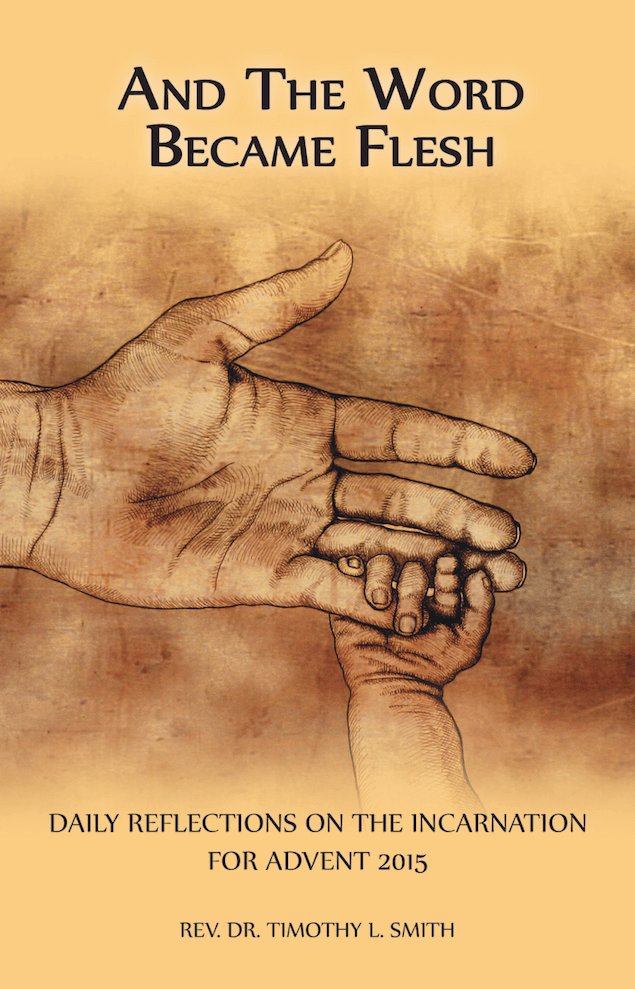
But I know that all the joy and delight I’m feeling comes from something far more grand and wondrous than bright lights, presents and parties. It all has to do with the solid, historical fact that Jesus was born at Christmas. His birth became the turning point for the world, and so changed the course of history that we still reckon time as B. C. (“Before Christ”), and A. D. (Anno Domini, “the year of our Lord”). When you sign a check or date a document you are witnessing to Jesus’ birth as the center of time. His birth defines the ages. No wonder we so want to celebrate Christmas!
While we talk about God coming down to us at Christmas, that is but a part of the story. Yes, God came down to us at Christmas, but came down in order to lift us up! The great Church Father, Athanasius, said of Jesus’ coming down: “He became what we are that we might become what He is.” (Athanasius, The Incarnation of the Word) Oxford scholar, C. S. Lewis, echoed Athanasius and other Church Fathers when he affirmed: “The Son of God became man to enable men to become the sons of God.” (C. S. Lewis, Mere Christianity)
This is the reason why angels sang their hearts out, and why shepherds worshipped and wise men journeyed far. It was because God the Father, Son, and Holy Spirit purposed to include us in His eternal circle of love. God outside of time became God in time. He made Himself small, the Infinite became an infant. The Son of God became the Son of Man to make us sons and daughters of God. God came down to lift us up to His life and glory!
It is the design of this daily Advent devotional to explore the rich mystery and wonder of the Word becoming flesh. During the frightening days of the German Third Reich, Dietrich Bonhoeffer, theologian, pastor and martyr, wrote a Christmas letter to German pastors and underground seminarians in which he said:
What a mistake to think that it is the task of theology to unravel God’s mystery, to bring it down to the flat, ordinary human wisdom of experience and reason! It is the task of theology solely to preserve God’s wonder as wonder, to understand, to defend, to glorify God’s mystery as mystery. (A Testament to Freedom: The Essential Writings of Dietrich Bonhoeffer)
This daily devotional hopes to “preserve God’s wonder as wonder” and glorify the mystery of the eternal God coming down to lift us up. It is a wonder and mystery to celebrate at Christmas and preserve throughout the year.
Often as theologians and Bible students talk about Christmas they throw around the ten-dollar word, “Incarnation”. This is a word from the Latin incarnate, a combination of the Latin in (same meaning as our English “in”) and carnis (“flesh”). Christmas is about the Incarnation, the enfleshment, God clothing Himself with our flesh. It is the Second Person of the Holy Trinity, God the Son, deigning to become fully human in all the ways that we are human, excepting sin. He is not a stranger to anything human.
But having a word like Incarnation doesn’t mean that we understand it, any more than having a word like electricity means we understand the push and pull of electrons and protons. As with electricity, we may not understand the mystery of the Incarnation, but we can live in its incomprehensible power every day. We can agree with Martin Luther, “…that He sunk Himself into our flesh is beyond our understanding.” (Martin Luther, Table Talk)
The Son of God becoming flesh means that Jesus is neither “half-and-half”, nor fifty percent God and fifty percent man. Jesus is one hundred percent God and one hundred percent man. He has made Himself bone of our bone, and flesh of our flesh, taking humanity into God’s self. He comes down to share our human condition and to share with us all that is His.
In the Incarnation Jesus reveals God to us, but also reveals us; He shows us who we are, and who we might become. The Incarnation also reveals that there are no limits to how far God will go in making us His beloved children. God reveals that He would rather die than forever live without us. He plunges daringly into our abandonment to share with us His eternal life.
C. S. Lewis compares the Incarnation to a strong man stooping low to lift a great burden:
In the Christian story God descends to re-ascend. He comes down, from the heights of absolute being into time and space, down into humanity, down further still, down to the very roots and seabed of the nature He had created. But He goes down to come up again and bring the ruined world up with Him. One has the picture of a strong man stooping lower and lower to get himself underneath some great, complicated burden. He must stoop in order to lift. He must also disappear under the load before he incredibly straightens his back and marches off with the whole mass swaying on his shoulders. (Lewis, Miracles)
All the self-giving love of Father, Son, and Holy Spirit overflowed in the Incarnation to include us in God’s life and glory. “The Gospel is all about the fact that the Son of God, who enjoys life with His Father in the fellowship of the Spirit, became human – came across to our side of the table – so that He could share nothing less than this life with us.” (C. Baxter Kruger, The Secret)
Let’s explore in this devotional what the Incarnation means for us in our everyday lives. That’s something to get excited about! That’s something to really celebrate!
SPIRITUAL PRACTICES FOR ADVENT:
EMBODIED PRAYERS
The Incarnation is about God coming to us in a body that we might return to Him in bodies. Bodies are essential to what it means to be human. While we might think that we “have” bodies, we actually “are” bodies. The apostle Paul calls for people to present their “bodies” to God as an act of “spiritual worship” (Romans 12:1). “Yet we sit here with our souls tucked away in this marvelous luggage, most insensible to the ways in which every spiritual practice begins with the body.” (Barbara Brown Taylor, An Altar in the World)
Because the Incarnation is about the body, our Advent spiritual practices are about the body, specifically Embodied Prayers. As we pray embodied prayers we are recognizing that “Classical Christian spirituality has paid close attention to the disposition of the body in prayer… bodily comportment for prayer is always significant.” (Rodney Clapp, Tortured Wonders: Christian Spirituality for People, Not Angels) C. S. Lewis in his Screwtape Letters suggests that body position has much influence on our praying, “since we are bodily ‘animal’ creatures, our desires and aspirations find expression in bodily form…So also the posture we adopt in prayer is an outward and visible expression of our real (and not just inward!) need for God.”
Our bodies do express and embody our praying. We don’t just think our prayers but express what we are saying with our bodies. Theologian Craig Dykstra observed, “…you can know things on your knees that you can’t know sitting down.” (Quoted by Teresa A. Blythe in 50 Ways to Pray) Because body position does influence praying, the Bible shows a diverse repertoire of prayer positions (e.g., standing, kneeling, head bowed, head raised toward heaven, bowing prostrate, sitting, lying, leaping, raising arms, sitting, and pounding the chest.)
Often we find that our thoughts and feelings cannot be put into the words of a prayer, so God has given us bodies. That’s why a man often kneels when he proposes marriage, or why we stand and place a hand on our heart for the National Anthem. Body positions can be expressive of what we are thinking and feeling. Compare this with today’s understanding of “body language” in which there is recognized nonverbal communication of thoughts and feelings through bodily behaviors. “The physical activity symbolizes an engagement of the whole being in the act of praying.” (“Prayer”, Dictionary of Biblical Imagery, ed. Leland Ryken, James Wilhoit, Tremper Longman III)
Through Embodied Prayers we mesh body and spirit, giving both a place in praising God, blessing Him, petitioning Him, lamenting, raging, and waiting in His presence. The different body positions accompany words, but sometimes they become prayers in and of themselves.
Each Sunday of Advent you will be introduced to an Embodied Prayer, or a bodily posture for prayer. You are encouraged each day of that week to pray the Lord’s Prayer in that posture. Note that each of these four Embodied Prayers are taken from the Bible and have been used by God’s people through the centuries. They are helpful in expressing and embodying our thoughts and feelings to God. Some of these Embodied Prayers might be new to you, or feel strange, but by practicing them for the week you will likely find them enhancing your prayers.
THE LORD’S PRAYER
Our Father in heaven,
hallowed be your name,
Your kingdom come,
Your will be done,
on earth as in heaven.
Give us today our daily bread.
Forgive us our sins
as we forgive those who sin against us.
Lead us not into temptation
but deliver us from evil.
For the kingdom, the power,
and the glory are yours
now and forever.



